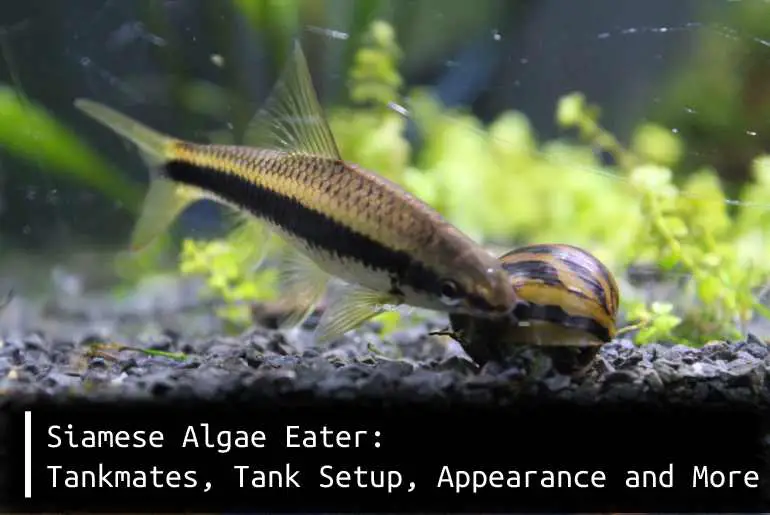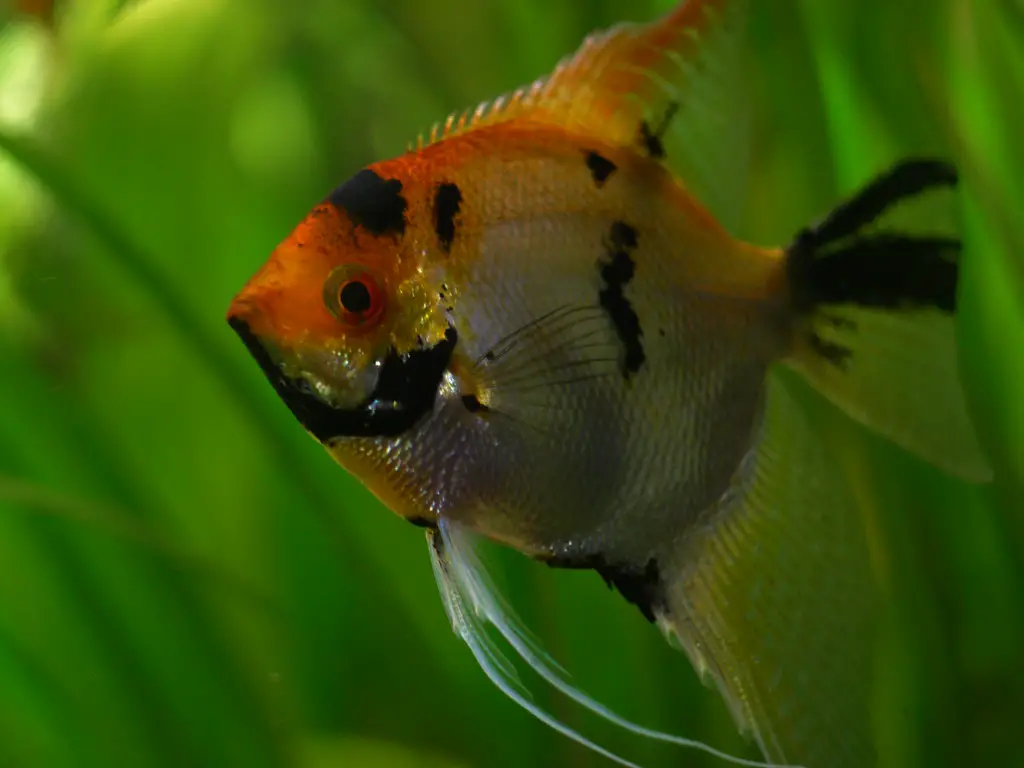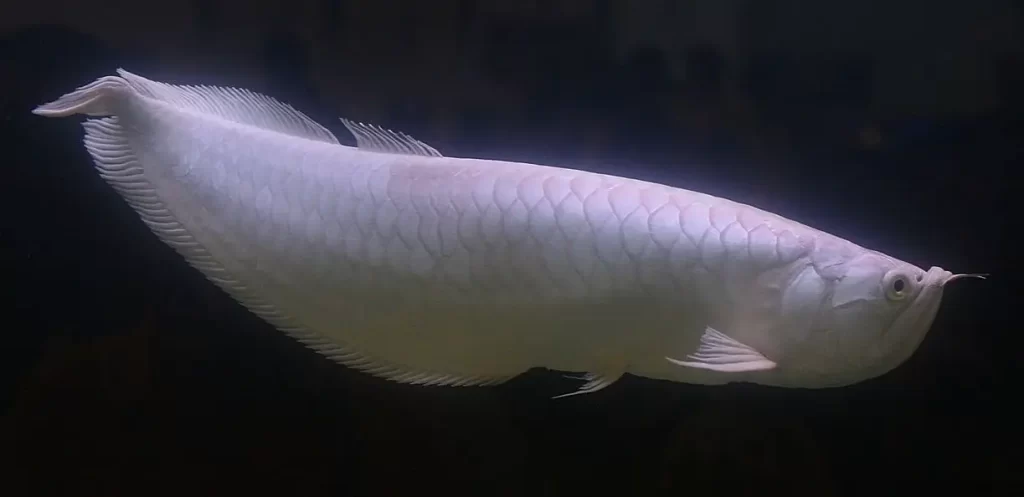Although they may not be the most beautiful creatures in your aquarium, seasoned aquarists understand the Siamese Algae Eater, a silver-gray striped fish.
The Siamese Algae Eater (Crossostoma langei) is a freshwater fish native to Southeast Asia. It is a member of the family Balitoridae, which includes many other species of cave-dwelling fish. The Siamese Algae Eater is a voracious eater of algae and is often used in aquaculture to control algae growth. The fish has a long, slender body and can grow to a length of around 15 cm (6 inches). It is typically brown or black in color, with a whitish belly. The Siamese Algae Eater is a peaceful fish that is incompatible with aggressive tank mates. It should be kept in an aquarium with plenty of hiding places and live plants.
Check out our detailed guide to see why these aquatic eating machines are among the best in the business at eliminating algae from aquariums with lots of plants.
Overview
Here we have explained the necessary requirements that you have met and follow to keep your siamese algae eater healthy and active:
Habitat and Tank Conditions
Siamese algae eaters can be found in Southeast Asia’s heavily forested rivers and streams in the wild. The nearly related Asian Carp has similar habitat preferences.
These tropical waters don’t typically have a strong current and are mildly acidic. There are much vegetation, rocks, and logs underneath the surface that serve as shelter.
An algae eater spends some time in these hiding places and sometimes looks for food on surfaces. In addition to other items which sink to the river’s bottom, this primarily consists of algae. They don’t make the finest explorers; they like to hang out near familiar shelters and hardly ever go above the water’s surface.
Tank Size
Any fish breed that wants to succeed needs a certain minimum tank size. This is so because different species have varied needs, and as a result, different species require different living and swimming spaces. What size tank do Siamese Algae Eaters require?
A tank that holds the Siamese algae eater must be at least 20 gallons in size. Remember that somehow this size is only suitable for one fish. You will need an additional 10 gallons per fish if you want to buy more or subsequently add new ones to the aquarium.
Because Siamese Algae Eater swims around everywhere swiftly, you need a lot of room. Additionally, it typically rests on the tank’s bottom. Consequently, you require a sizable aquarium.
Because they scrape the bottom for leftovers, they spend lots of time here. But most significantly, they scan the tank for algae. They won’t move from an area of the aquarium’s bottom that is coated with algae till the algae are completely gone.
Water and Temperature Parameters
As long as they are consistent, Siamese Algae Eaters adapt effectively to a wide range of conditions and are not susceptible to water hardness. Although they can survive a pH as low as 6.0, they prefer water with a pH of 6.5 and 8.
Their preferred temperature is the main restriction. You’ll need a heater because SAEs have a limited range and enjoy their water under tropical conditions between 75 and 79°F.
Tank Mates
Siamese algae eaters get along with a variety of fish and are not aggressive. These calm community species that frequent regions that Siamese Algae Eaters avoid provide the perfect tank companions for these algae eaters, while they also go with other non-territorial bottom feeders such as Corydoras and loaches.
Considering fish, including tetras, minnows, danios, tropical fish, platys, including mollies, and gourami, as well as gentle barbs such as the Gold, Cherry, and Rosaline Torpedo as Siamese Algae Eater companions since they are school swimmers with short fins. Invertebrates, including snails and tiny freshwater shrimp, are also compatible with them.
Keep your Siamese Algae Eater away from territorial sharks, cichlids, and sharks, as well as semi-aggressive fish such as Tiger Barbs. It’s better to avoid having angelfish or discus without SAE because they might nip into slow-swimmers on long tails, yet I’ve largely kept both with such a male Betta fish in a sizable community aquarium.
Difficulties In Keeping
The fish is indeed a calm, energetic, and unobtrusive creature. In addition, this is among the few species that can combat algae in a pond. The primary Siamese Algae Eater oddity is that it can consume black beard algae, whereas other fish cannot even approach this type of algae.
However, you must overfeed the fish in order to make Siamese Algae Eater consume BBA; otherwise, it won’t eat it. Adult plants prefer genuine or artificial ingredients, whilst juvenile species consume black beard algae relatively enthusiastically.
Food and Diet
They are categorized as macrophages, and in their native habitat, they prefer to eat biofilm in the decorative elements of periphyton and phytoplankton. Additionally, they are not picky eaters in aquariums, and they will consume practically any meal, including algal crackers, flake and pellet feed, and live foods.
Protein-rich foods should not be offered because they cannot be metabolized effectively. High-protein diets that are consumed often and for an extended period of time might cause excessive fat buildup and potential organ deterioration. Similar caution should be used when feeding Siamese Algae Eaters. If you overfeed the fish, they may stop eating the algae and start eating solely what you offer them.
According to folklore, adult Siamese algae feeders rummage around the furniture and consume seaweed. However, they don’t consume algae. Instead, because of its activity on many surfaces, the adult fish prevents the growth of algae.
Some of my suggestions would be:
- Omega one pellets
- Ocean Nutrition Instant Baby Brine Shrimp 0.7-Ounces (20 Grams) Jar
- Omega One Freeze-Dried Blood Worms, 0.96 oz
- Hikari Bio-Pure Freeze Dried Daphnia for Pets, 0.42-Ounce
- Hikari Tubifex Worms Fish Food (0.7 oz.) [Set of 2]
Care
The fishes are not very prone to any illnesses.
This fish only needs a good filter, algae, as well as a clean tank to survive.
They are dependent on currents and constant motion to stay afloat because they possess a swim bladder. To allow the fish to swim, your filter has to create a current. You must also give this fish enough room so that it can move freely throughout the day.
Avoid packing the tank too tightly with plants or ornaments.
- Organ issues are far less likely to be brought on by high-quality diets. Cheaper foods may lead to constipation, which frequently has severe consequences.
- Every two weeks, water should be changed to prevent the accumulation of pollutants because dirty water is analogous to breathing polluted air.
- Watch what you put in your tank. Toxins from decorations and disease-carrying water from several other aquariums are both possibilities.
Common Diseases
Siamese Algae Eaters are generally sturdy, disease-resistant fish that are not prone to illness. But then in poor management aquariums with ongoing parameter instability, this fish can contract illnesses like Ich.
Ich
Among the most typical illnesses found in tropical fish aquariums is ich. Its symptoms include microscopic white spots that resemble salt grains, mostly on skin and gills, frequent body rubbing against environmental items, a lack of appetite, and unusual hiding behavior.
Forgetting to isolate a new fish introduced to the aquarium is the most frequent cause of Ich. Since only one infected Ich parasite is required for a whole tank or pond to become infected, most fish will “appear healthy” and not exhibit any symptoms of illness until the parasite has gone through several life cycles, which could also take just several days to a few depending on the water temperature. All new fish should be safely quarantined to prevent the transmission of Ich to your primary tank.
Fungal Infections
Among the most prevalent ailments affecting temperate fish are fungi. Because fish under stress might become afflicted by fungal spores, which are present in all fish ponds, a rise in fungal diseases in a fish population that is otherwise healthy might also be caused by poor water quality.
Fish become infected with the Saprolegnia fungus, which damages their internal organs, including deeper tissues. Light gray, spongy growths just on the surface, fins, lungs, and eyes are symptoms. Older tank fish are most commonly affected by the Ichthyophonus hoferi fungus. It is a rare fungal infection, though, and it usually results from eating raw fish that has been contaminated. It could be lethal for the fish if not treated.
The signs and symptoms vary depending on the species. However, unlike Saprolegnia, it causes a tiny black growth on the skin. Additionally, this fungus causes fish to occasionally swim in strange circular motions, lose color, develop ulcers & cysts in vital organs, and develop protruding eyes.
Lifespan
The average lifespan of a siamese algae eater is 10 years, which is a rather long time for a tank fish. Although it is quick and nimble, it enjoys taking occasional breaks from activities. It frequently picks a few tank plants with broad leaves to sprawl out on. The same effect can be achieved by the juveniles using narrow leaves or tank plants. They lay mostly on the tank bottom because there are no suitable plants present.
Aquarium Size And Shape
Siamese Algae Eaters perform better in tanks that seem to be long instead of tall since they spend a greater amount of time, mostly in the lower parts of your tank. They require a cover or lid to protect them from harm because they are quite active and might jump out. For one Siamese Algae Eater, I advise a tank of at least 20 gallons, and for each subsequent fish, I advise a tank of about 10 gallons. For 5, a 55-gallon container is ideal.
Breeding
Siamese Algae Eaters were also regrettably one of several aquarium fish that really is extremely difficult to visibly sex. Females can grow by up to 30% when fully mature, but it often requires 3 to 4 years.
Males and females currently have completely identical patterns and sizes. There is no need to select males or females because they are raised in Southeast Asia in large numbers through outdoor ponds that receive abundant tropical sun that promotes continuous algal development.
In-home aquariums, breeding is nearly unheard of. The most effective approach to achieve this is to develop a young colony of about four to six individuals inside an aquarium with lots of plants. These Siamese Algae Eaters will have the perfect home thanks to that same plant, algae, full-spectrum sunlight, and biofilms!
FAQ
How Long Do Siamese Algae Eaters Live?
Siamese algae eaters have a ten-year lifespan. Siamese algae eaters have a relatively long lifespan since they are adaptable and don’t have particular preferences.
You can take the following steps to make sure your Siamese algae-eating fish enjoy healthy and long lives.
- Do not overfill the tank.
- Keep them away from territorial and aggressive tankmates.
- Give the tank a large number of live vegetation, decorations, and hiding places.
- Maintain a soft substrate inside the tank.
- Keep the water between 72 and 79 degrees Fahrenheit (22.2 and 26.1 degrees Celsius).
- Either once or twice a day, or give them diversified, omnivorous food.
- To stop them from leaping out of the tank, keep a cover on top of it.
How Big Do Siamese Algae Eaters Get?
Siamese algae eaters have a maximum length of six inches (16 cm). These fish on the bottom get bigger than most freshwater fish do. They can grow up to 6 inches long and occasionally much longer when kept in the proper habitat.
How Many Siamese Algae Eaters Can You Keep In An Aquarium?
The little groups of 5 to 6 Siamese Algae Eaters function well. They enjoy attending school together. However, you can also have one or two inside the aquarium at a time. They won’t experience any bad effects from it.
Do Siamese Algae Eaters Produce A Lot Of Waste?
Siamese algae eaters seem to be charming animals that thrive when grouped in a classroom. Keeping several of them will not only maintain your tank fresh but will also allow you to take advantage of heightened activity at the bottom. Since they still produce a lot of waste as fish, overcrowding may result in some more chaos than cleanliness.
Is Siamese Algae Eater Aggressive?
Siamese algae eater seems to be generally not combative fish. It is regarded as tranquil and won’t damage other fish tank residents. There is one restriction to this, though. The males have some territorial behavior toward one another.
Conclusion
As you’ve seen, these fish can survive without a lot of care and are a terrific and entertaining addition to pretty just about any freshwater aquarium.
Just take better care of their necessities, and they’ll repay the favor by maintaining the algae in your aquarium!
We trust that you now have more knowledge about the Siamese algae eater species and how to support its survival. You can always contact us and let us know whether you have any comments or questions about this fish.






